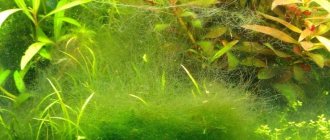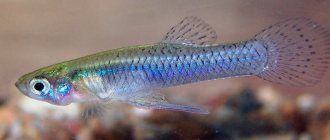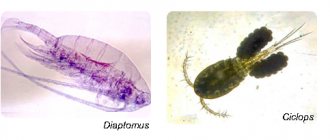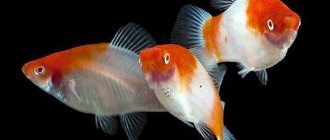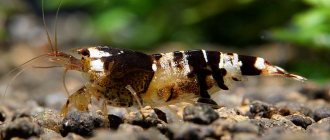Aquatic plants supply underwater inhabitants with vital oxygen, act as a biological and mechanical filter (purify aquarium water from mechanical suspensions), and also remove harmful substances from the aquarium, in particular excess nitrates. Among aquarists you can find hobbyists who do not use live plants in their aquariums for many reasons.
An example is a biotope aquarium inhabited by cichlids from Lake Malawi, which has a rocky bottom landscape with virtually no vegetation of any kind. Some aquarists simply don’t want to go through the hassle of caring for the grass because it doesn’t bring them pleasure. Considering this point, a completely logical rule of aquarium husbandry comes to mind: “It is better to have no living plants in the aquarium at all than one stunted bunch of cryptocoryne or something else, since it spoils the entire appearance and poisons the aquarium water with rotting organic matter, provoking the development of lower plants (algae)". Therefore, our task for today is to decide on ways to help underwater inhabitants do without aquarium plants.
To dot the I’s, let’s look at what main functions the plants perform in the underwater kingdom of the aquarium and let’s decide how we can replace them if there are none, or compensate a little.
Main functions:
- Purification of aquarium water from contaminants;
- Carbon dioxide consumption;
- Absorption of organic and non-organic compounds;
- Participation in the life processes of aquarium inhabitants.
Nitrate content in the aquarium. Where?
Where does it come from in the aquarium? Everything is simple here. The fish poop and the uneaten food breaks down, thereby producing ammonia. Bacteria living in the aquarium, for example, in the soil and in the filter, convert ammonia into nitrites. Nitrites are not a very stable compound and, with the help of bacteria, break down into nitrates. Ammonia and nitrites are very dangerous for aquarium animals. High concentrations of these substances can cause poisoning or even burn the gill covers of fish. Nitrates, in turn, are much safer. And if you have live plants, a slightly higher nitrate level in the aquarium may even be beneficial. In small concentrations, they provide nutrition for your green garden. Okay, I'll get ahead of myself a little. Nitrogen is one of the three most important macroelements in plant nutrition. But more on that later.
However, if the concentration of nitrates in the aquarium is high, then the fish can also be poisoned. The level of nitrates in an aquarium may differ for some types of fish. As a rule, it varies from 50 mg/l to 100 mg/l.
In an established aquarium, nitrate levels vary from change to change. Over the course of a week or two, it remains within acceptable limits, but gradually increases. When you do a water change, the level of nitrates decreases and the fish will not be poisoned. And the accumulation of nitrogen compounds begins again. This is why beginners’ fish often die when they don’t make changes. Also, the decomposition of nitrogen compounds is one of the reasons why there is no need to overfeed the fish. After all, the food also disintegrates.
Therefore, it is important to do regular tests of the aquarium water. There are special tests for nitrites/nitrates/ammonia indicating acceptable concentrations and detailed instructions. If you want to be sure that your fish are doing well or, conversely, find out the reason for their death, then simply test the water.
Here is an example of nitrate test results
Symptoms of subacute and acute poisoning of aquarium fish with nitrites are as follows:
- loss of brightness of color: fish darken, and in some species black spots of irregular shape appear on the body;
- decreased activity: fish stand motionless in the corners of the aquarium for a long time, even if this does not happen, their mobility in general decreases, fins with nitrite poisoning are often compressed;
- severe mucusing of the gills, expansion of individual respiratory folds and degradation of others;
- deterioration of appetite up to refusal of food;
- change in the color of the gills, they become yellowish-brownish or brown (with chronic poisoning with relatively low concentrations of nitrites, the color of the gills becomes pale pink);
A change in the color of the gills and blood of fish from red to brown is a specific symptom of subacute and acute nitrite poisoning of fish.
| Photo 1. Symptoms of fish poisoning with nitrites: the color of the gills becomes brown, in severe cases it turns brown. The blood also turns brownish. Insets show a healthy carp gill (on the left in a green frame) and a carp gill with acute nitrite poisoning (on the right in a gray frame). The arrow is a blood smear; it has a pronounced brown tint. The operculum is cut off, revealing brown gills. | |
| Video 1. Viewing a temporary wet preparation of gill filaments of a carp with acute nitrite poisoning. Red arrows mark abundant mucus secretion around the gills, black arrow points to one of the greatly enlarged (edematous) respiratory folds. It can be seen that there are many such folds. The color of the gills is brown. Some fish, such as goldfish and red parrots, develop black spots on their bodies (marked here by arrows) when exposed to nitrites. | |
| Video 2. Red parrots after subacute nitrite poisoning. At the time of filming, the necessary measures to help the fish had already been taken, so of all the symptoms, only these black spots remained, which disappear no earlier than a week after the effect of nitrites on the fish ceased. | |
| Photo 2. With chronic nitrite poisoning, severe darkening of certain parts of the body and fins of goldfish is possible. This change in color goes away within a few weeks after the fish are no longer exposed to nitrite ions. | |
How to raise nitrates in an aquarium?
Yes, and this may be necessary. If you have lush vegetation in the aquarium, then for full growth, it may not have enough nitrates, which are formed from various types of decomposition. The addition of nitrates acts solely as a fertilizer. Just like in a regular garden! There are two simple ways to raise nitrate levels:
- Add more livebearers. Everything is simple here. They produce more excrement and therefore more nitrates from decomposition
- Apply macro fertilizers or nitrogen fertilizers.
How does nitrite harm fish?
Nitrite penetrates through the gills into the bloodstream and affects the body of the fish.
First of all, the oxidation of iron found in hemoglobin is observed, methemoglobin is formed, which is not able to bind oxygen. This process, called methemoglobinemia (cyanosis), manifests itself as brown blood, difficulty breathing, or even choking.
Nitrite is also toxic, destroying liver cells, gills and blood cells.
Long-term exposure to nitrite leads to a weakened immune system, and fish begin to suffer from infectious diseases such as ichthyophthyriasis or bacterial infections (fin rot and peptic ulcer).
NO3 norm and limit values
Most aquarists recommend maintaining nitrate levels within the normal range of 20-30 mg/l.
However, for some particularly sensitive residents it is necessary to reduce the value of this indicator to the level of 15-20 mg/l. The maximum value of this substance is 40 mg/l.
Any deviation from the standard indicators, depending on the sensitivity of the inhabitants, may endanger their health. This will entail:
- decreased immunity and appetite;
- slowing down their growth;
- increased lethargy;
- deterioration in appearance (color fades, spots appear);
- cessation of spawning;
- death.
Answers to the most frequently asked questions – Nitrite
What is nitrite?
Nitrite (NO2) is a highly toxic pollutant that is formed when bacteria break down organic waste that accumulates in an aquarium through a process called nitrification.
Beneficial filter bacteria Nitrosomonas oxidize deadly ammonia (NH4) from decaying fish tank waste to nitrite, which is slightly less toxic to fish than ammonia. Then a number of other bacteria, such as Nitrospira and Nitrobacter, convert the nitrite to nitrate (NO3) , which is slightly toxic compared to nitrite. It is very important to regularly test your water for the presence and levels of ammonia, nitrites and nitrates.
Why are nitrite levels rising?
The level of nitrites begins to rise in a situation where an excessively large volume of pollutants accumulates in the aquarium, which at the moment cannot process the existing colonies of beneficial bacteria in the aquarium.
The number of filter bacteria is directly proportional to the amount of contaminants entering the aquarium. It takes some time for the bacteria to grow to the level necessary to process all the pollutants produced by the fish.
And while the bacteria will increase their volume in an attempt to consume all the food available to them, the water will be contaminated with ammonia and nitrite, which has an extremely negative impact on the condition of the fish. If the amount of organic waste produced in the aquarium is approximately the same each day, the ammonia and nitrite levels should be zero.
What Causes Increased Nitrite?
The most common reasons are overfeeding fish and overcrowding of the aquarium, improper filter maintenance, as well as the “new aquarium” syndrome.
A new aquarium filter or an existing filter, the media and sponges of which have been washed in chlorinated tap water or replaced with new ones, contain a small number of bacteria that are not able to remove a large amount of contaminants. On average, bacteria need 4 – 6 weeks (depending on the temperature and chemical properties of the water) to grow to the required level.
Therefore, it is necessary to rinse the filter material in water drained from the aquarium, and in no case under the tap, and the replacement of filter media should be carried out gradually, and not all at once.
To accelerate the growth of bacterial colonies in new filters, it is recommended to move some of the filter material from the existing old filter, or use specialized bacterial cultures, such as Tetra Bactozym .
If you have a new aquarium, do not try to stock a large number of fish at once, and feed them in small portions. The more contaminants that enter a new, unripe aquarium, the more dangerous the conditions will become for the fish.
| "Answers to the most frequently asked questions - Ammonia" |
How can nitrite harm fish?
Nitrite enters the fish's bloodstream through the gills and can cause harm in several different ways.
First of all, nitrite oxidizes iron ions in hemoglobin molecules with the simultaneous formation of a methemoglobin molecule (methemoglobinemia), as a result of which the processes of oxygen transport in the blood are blocked. The color of the blood changes to dark brown, breathing becomes very difficult, and as a result, death from suffocation.
Nitrite also accumulates in the body, causing poisoning that damages the liver, gills and blood cells.
Long-term exposure to nitrite leaves the immune system vulnerable and fish may begin to suffer from bacterial infections, fin rot, ulcers and abscesses if they are still alive and have not died from poisoning.
What symptoms may appear in fish due to nitrite poisoning?
Due to breathing problems, fish swim to the surface (the oxygen content is highest at the surface of the water) and hang there, moving their gills rapidly in an attempt to inhale oxygen. The fins are tucked close to the body. If any of the fish in your aquarium begin to exhibit this behavior, it is necessary to urgently test and determine the level of nitrite in the aquarium water.
Is nitrite toxic to all fish?
Different species of fish and even different individuals of the same species have different resistance to the destructive effects of nitrite on their body. Some species, for example, can reduce the rate at which it enters the bloodstream through the gills. Therefore, not all fish in an aquarium or pond will necessarily get sick or die as a result of elevated nitrite levels.
What level of nitrite in water should I aim for?
The nitrite level should always be zero or as close to zero as possible. Under certain conditions, even relatively low nitrite levels of 0.25 mg/l can be harmful to sensitive fish species. All values above 0.1 mg/l should be considered unacceptable and potentially dangerous. Although some types of fish may not show symptoms of poisoning even at very high levels.
| "Escape behavior of aquarium fish" |
What to do if nitrite levels are elevated?
First of all, it is worth finding out what was the impetus for the sharp increase in nitrite levels in aquarium water, eliminating the cause and making sure that this does not happen again. Then do a large ( 50% or more ) partial water change to reduce the nitrite concentration.
It is recommended that after elevated nitrite levels are recorded, daily testing (monitoring nitrite levels) is carried out for some time; this will allow you, if necessary, to make a prompt water change and thereby save the fish from death.
The negative effects of nitrite on fish are always greater when dissolved oxygen levels are low, so be sure to use an air compressor or venturi on the internal filter . Keep a close eye on your fish and watch for the first signs of any diseases.
What can be added to make nitrite less toxic to fish?
Aquarium salt (sodium chloride) has long been used as an adjuvant to reduce nitrite toxicity, as the addition of salt has been shown to prevent the development of methemoglobinemia under certain conditions.
Some fish keepers do not like to use salt, but years of experience have shown that when added in the correct dosage, salt never causes problems, even in species considered salt intolerant.
Fairly low levels of salt can have a significant effect on reducing nitrite toxicity, so there is no need to add large amounts. Research shows that a 10:1 dosage (just 10 mg/L salt per 1 mg/L nitrite) is effective for most freshwater species.
Adding salt to prevent disease or to solve osmoregulatory problems requires higher doses!
How does adding salt help with nitrite poisoning?
When salt is added to the water, a chloride ion appears, which reduces both the manifestation of methemoglobinemia and the toxicity of nitrite in the blood. However, it is interesting that the presence of chloride has always been ensured by the addition of sodium chloride, recent research has shown that it is possible to use calcium chloride, which may be even better, because the addition of calcium also reduces the permeability of the gills, resulting in less nitrite entering the blood of the fish.
For this reason, fish kept in water with higher levels of calcium and chloride are generally less sensitive to nitrite than species kept in fresh water with low concentrations of chloride and calcium. That is, theoretically, fish kept in warm, soft water (for example, Discus fish) are more at risk, but be careful, nitrite is harmful to all types of fish, regardless of the properties of the water!
| “Heavy metals in aquarium water - Lead and Copper” |
Matt Clarke for Practicalfishkeeping.co.uk Translation and adaptation of the text: V. Luft specially for www.akvabluz.ru | © Copying of materials is prohibited
How to test water at home for these compounds? ?
The first visual indicator that there is a deviation from the norm in the direction of increasing nitrate content in the aquarium is the active growth of aquatic plants.
In order to determine the amount of this nitrogen compound, you will need to make samples using special tests . In this case, a beginner will need special skill, not so much in performing the test itself, but in determining the results - the difference in the color of the sample from the sample in the range of standard values.
In pet stores you can find a large assortment of nitrate tests with detailed instructions for use from various manufacturers - Aquarium Pharmaceuticals, SERA, NILPA, Tetra. They are either test strips, drop tests, or electronic tests.
The advantages of test strips include ease of use - dip them in water and compare the result with the proposed scale. They also belong to budget indicators and are sold individually. The big disadvantage is the approximate nature of the obtained values.
Drip tests are a special reagent that, when interacting with a water sample, colors it a certain color. The resulting color is then compared to a color scale and the nitrate concentration is determined. Such tests are a product with a good price-quality ratio, and they are sold for checking both one and a group of indicators.
Electronic devices for determining the value of a substance in water have a digital display and a probe that is immersed in water. The main advantage is that they give specific numbers. Among the disadvantages is the high cost of the device.
How to keep nitrate levels low?
The most common cause of elevated nitrate levels is overfeeding your fish. Regular partial water changes, up to 25% every week or two, will help keep nitrate levels low. It is recommended to change the water using a gravel cleaner with a siphon, at the same time as changing the water, removing debris and organic residues from the soil.
Nitrate removing filter media will help keep nitrate levels very low, but it will not replace many water changes.
What can be done to reduce the toxicity of nitrite?
Administration of sodium chloride is always used to reduce the toxic effects of nitrite. The mechanism of action is the competition of chloride contained in the salt with nitrite for absorption by the gills, which significantly reduces the formation of methemoglobin. Interestingly, recent studies indicate the applicability of calcium chloride, which, in addition to chlorine, introduces calcium ions into the solution, which reduce the ionic permeability of the gills and, accordingly, the access of nitrite to the blood.
For this reason, fish that live in water with high levels of calcium and chlorine are usually less susceptible to nitrite than fish that live in less calcium- and chlorine-poor environments. It is worth noting that this rule applies to freshwater species, while many marine fish species are extremely sensitive to the concentration of the toxin.
Theoretically, individuals living in soft and warm water (discus fish) are at greater risk of poisoning.
Some breeders do not like to add salt, however, as experience shows, moderate doses of chloride will never harm fish, even species sensitive to it.
Addition of 10 mg/l sodium chloride with a toxicity of 1 mg/l nitrite is very effective for most freshwater species. For example, in the case of rainbow trout, which were in water with a NO2 concentration of 12 mg/l, increasing the Cl- level from 1 to 41 mg, it was possible to reduce toxicity by 96%. To regulate osmosis and associated diseases, a much higher concentration of salt will be required.
What should I do if my tap water has very high levels of nitrate?
If you keep sensitive fish or invertebrates, then all water added to the aquarium during changes must be passed through a special nitrate-removing resin or tap water filters before use.
A reverse osmosis filter is the best solution because in addition to nitrate, it filters out metals and pesticides, reduces water hardness, etc., making it ideal for fish species that prefer soft water, as well as sensitive marine species.
Nitrite toxicity to various fish
Different species of fish, or even representatives of the same species, demonstrate different susceptibility to nitrite. Some species may reduce the degree of blood supply to the gills. For example, the lethal concentration for rainbow trout is 0.1-0.4 mg/l, for mosquito fish (Gambusia affinis) - 1.6 mg/l, and for channel catfish - 10 mg/l. This concentration is the so-called LC50 indicator, at which half of the entire livestock will die within 3 days. In a community aquarium or pond, not all fish will necessarily die or become ill when nitrite levels rise.
In addition, toxicity is determined by the chemical parameters of water. In an acidic environment, NO2 is more toxic.
Use of special filter media.
Now, modern aquarium filters already provide fillers for all occasions, including the case of high nitrates . These are either specially impregnated sponges, for example, Juwel Nitrax . Or granular fillers such as Seachem De*nitrate
, or
API NITRA-ZORB . They may not lead to an immediate effect, but in the future they will keep nitrates
at low levels stably and for a long time.
Using special chemicals for the aquarium.
Almost every manufacturer of aquarium products has a special additive that can instantly reduce the level of nitrates in the water. For example, Tetra NitrateMinus , or Sera Toxivec . The latter not only reduces nitrates in the aquarium, but also removes ammonia , nitrites , chlorine , and heavy metals . I think you should always have it on hand in case of unexpected situations in the aquarium.
About water testing
Modern pet stores selling aquarium products have available control tools in their arsenal. The choice is up to the owner:
- Test strips for each parameter.
- Comprehensive test strips that determine several parameters at once.
- Drip tests - they are cheaper than strips, but they are more hassle.
- Electronic meters.
If the fish are especially expensive and valuable, you can install a controller for the aquarium: it not only measures the parameters at the correct intervals, but can also automatically adjust the indicators.
Folk method using vodka.
Without going into scientific terms, the essence of this method is that vodka in the aquarium provokes rapid growth of beneficial bacteria that remove nitrates from the aquarium. But this method is more suitable for marine aquariums. And it is necessary to strictly calculate dosages that are safe for fish and at the same time effective in reducing nitrates . Therefore, it is better to leave this method for professionals. And why use it, if water conditioners are more effective and much safer for the inhabitants of your aquarium.
Conclusions!
Nitrates are not as deadly as ammonia or nitrites. But their excess can cause such troubles as weakened immunity in fish and uncontrolled growth of algae in the aquarium. And since they are at the end of the nitrogen cycle chain, a decrease in the first two will most likely lead to a decrease in nitrates
. In other words, do regular tests and monitor the chemical balance in the aquarium.
10 COOL INTERNAL FILTERS FOR AQUARIUM.
NITROGEN CYCLE IN AQUARIUM
INTERNAL FILTER FOR AQUARIUM WITH YOUR OWN HANDS.
What can cause nitrite levels to rise?
Overfeeding and overcrowding can lead to increased nitrite levels, but the main cause is improper filter media maintenance and new tank syndrome.
Purchased filters, or filters after washing the filter material with too hot water or detergents, contain a small amount of ammonium and nitrifier bacteria, which are unable to process the entire volume of organic matter. As a rule, it takes 4-6 weeks to establish equilibrium, which also depends on the temperature and chemical parameters of the water.
The rate of bacterial development can be increased by adding media from old filter material to a new filter, or by introducing a bacterial starter culture and nutrient medium.
After purchasing a new aquarium and filter, you should not overcrowd the tank and overfeed the inhabitants.






